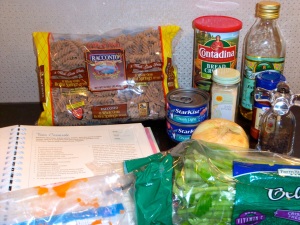One of the changes I am working to make permanent in 2011 is to plan ahead with meals and increase my cooking at home, both to prevent mindless nibbling as well as save us a little bit of money on the food budget. I’m also hoping this helps me shed a few of the fifteen pounds I managed to pack on through 2010!
Inspired by my new Jessica Seinfeld cookbook (thanks, Mom!), I’ve done pretty well so far. And Sweet Pea has even expanded his pallet a little to try some new things! But when I look at how the grocery bill has ballooned, I have to think twice about how I’m going about my weekly food shopping.
To that end, I’d like to share some food savings tips from the August, 2010 issue of O Magazine . I hope they help you too with your financial resolutions today and throughout the year!
Fish and seafood: Frozen fish is a great way to save, as much of the “fresh” fish at the grocery has already been frozen (the label will tell you this). If you want to splurge, wild Alaskan salmon is worth the money and is certified as sustainable by the Marine Stewardship Council.
Baking ingredients: Skip the name-brand sugar — you can’t tell the difference between the much less expensive store-brand. But when it comes to vanilla extract, experts say it is worth the extra money to buy the real deal.
Cookware: Cookie sheets and stock pots don’t require any fancy materials or coatings, so go ahead and buy the cheapest on the shelf. But don’t scrimp on a good skillet that you’ll use for things like searing or sautéing. You’ll appreciate the even distribution of heat offered by a high quality pan.
Liquor: I know this one from personal experience: if you’re going to mix vodka with anything (even olive juice, like my favorite cocktail), no need to buy the good stuff. Vodka is like tofu — it adopts whatever flavor you add to it. Save your money for a delicious bottle of single malt scotch!
Spices and herbs: Most name brand spices don’t offer anything different than generic brands, so go ahead and cheap out there. And when it comes to buying fresh versus dried, Alejandra Ramos advices that the only time you REALLY need to use fresh is when the recipe calls for basil and parsley.
Organics: The rule of thumb for buying organic produce is that if it’s sweet, go organic. But if it is a fruit or veggie with a thicker skin like onions, bananas or avocados, you’re safe from pesticides anyway.
Olive oil: If you’re going to cook with it, regular olive oil will do just fine. And if you’re making a dressing, you can mix two-thirds cheapie with one-third fancy and still enjoy great flavor. If you’re drizzling over food though, go for the good stuff.
Fruits and veggies: If a vegetable is out of season, buy frozen without losing a lot of the nutrients. Not sure what’s in season? Check out Eat the Seasons, a website updated weekly with what IS in season. Brussels sprouts, anyone?
Cheese: I saved the best for last, one of my diet staples. The only time you ever really need to go high-end on cheese is when you’re doing a cheese plate or fondue. Otherwise, go economy when serving with crackers, in meals, salads or even when grating over food.
I hope you’ve found some information to help with your next trip to the local market. Anything I missed? What grocery store tidbits can you offer? Anyone care to disagree with any of the above?
Kelley C. Long is a Chicago-based financial coach who believes you shouldn’t have to have a million bucks to receive personalized financial advice. Check her out at www.kelleyclong.com.
Tags: achieving goals, budgeting, financial planning, grocery shopping, jessica seinfeld cookbook, Money-saving tips, shopping deals

Leave a comment